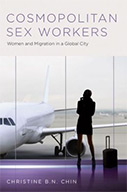Cosmopolitan Sex Workers: Women and Migration in a Global City
 Author: Christine B.N. Chin
Author: Christine B.N. Chin
Publisher: New York: Oxford University Press, 2013. 234 p.
Reviewer: Sharon S. Oselin | September 2013
Cosmopolitan Sex Workers presents an insightful analysis of the women who migrate for sex work, the organizations that facilitate these placements, and the hierarchies that persist within the trade, all of which unfold in a Global South city – Kuala Lumpur (KL), Malaysia. The forces of neoliberal globalization generate the conditions, opportunities and arrangements of prostitution within this setting. With such an ambitious agenda, Chin sets a high bar for the promise of this book. Impressively, she meets that challenge and exceeds it through rigorous scholarship that draws on data collected over multiple years.
While there is growing scrutiny of international sex trafficking, similarly linked to globalization, her book captures the alternative tale of those who willingly choose to relocate to perform sex work. In Cosmopolitan Sex Workers, Chin is able to weave a coherent narrative that bridges macro, meso and micro perspectives, which enables readers to gain an in-depth understanding of the multi-level nature of sex work in KL. This study reveals the tenuous balancing act that exists among the state, various organizational networks (which she calls syndicates), and transnational migrants who intend to work in prostitution.
To structure and organize this book, she employs a “3C” framework – city, creativity, and cosmopolitanism – that guides the reader through its seven chapters. Chin uses multiple sources of data throughout the book, including newspaper articles, state generated advertisements and statistics, statements from state officials, interviews with sex workers, syndicate workers, and third party actors, and field observations. As she notes in the Introduction, her diverse personal background and the multiple positions she occupies (e.g. woman, academic of Malaysian Chinese ancestry, professor who lives and works in the U.S.) afforded her access to a wide-range of individuals and agencies that may otherwise have remained off limits.
In Chapter Two, she delves into the history of KL as it transitioned from a British colony to an independent state that embraced a neoliberal development path and restructuring. To be competitive and alluring to outsiders, KL strived to cultivate a knowledge-based economy while attracting international tourists and students. The labor of migrant workers is key to sustain and further this growth, and it includes increased opportunities for sex workers in the city.
Chapter Three demonstrates how the state relies on border management strategies to regulate migrant flows. To that end, Malaysia upholds policies that encourage diversification of migrant nationalities and depends on the Malaysian citizen-civilian volunteers to police and monitor transnational migrants. In an effort to illustrate public sentiment about this population, Chin includes compelling quotes from newspaper articles as well as statements from public officials. As regulations become stiffer, with the intention to deter prostitution, actors and organizations become adept at surmounting obstacles in order to carry on daily operations.
Chapters Four, Five and Six showcase perspectives from sex workers, syndicate affiliates, and others with insight into the sex trade. Chapter Four summarizes the history of prostitution in the city of Kuala Lumpur, noting the waxing and waning of transnational migrant sex workers. Chin explores the reasons why migrants decide to engage in this type of work and the extent to which structural forces inform their decisions. Chapter Five examines one of the eight organizations – Syndicate X – that facilitate migrants’ placement in the sex trade within the city. Although some migrants do this independently, a majority depends on syndicates, which utilize a global network for recruitment of workers. Syndicate X is quite successful due to its extensive social networks and relationships with government officials and business owners throughout KL and beyond. In Chapter Five, Chin does an excellent job elucidating the organizational structure and business model of Syndicate X, which varies from the structure of its predecessor – the Chinese secret societies. Over time, and with the expansion of neoliberal globalization, she concludes the configuration shifted from “a hierarchically and tightly organized secret society to a more horizontally structured business group.” Chapter Six investigates the cosmopolitan subjectivities of the female migrant sex workers and members of Syndicate X in terms of their perceptions and experiences in a diverse, multi-racial and multi-cultural environment that paradoxically remains racially and ethnically stratified.
In the concluding chapter of the book, Chin summarizes the contributions of her study. While there are too many intriguing findings in Cosmopolitan Sex Workers to enumerate them here, a few are particularly noteworthy. First, Chin does an outstanding job highlighting the entrenched “racialized-ethnicized and gendered profiling” that occur for all migrants, but especially for those immersed within the sex trade. These hierarchies are maintained at the state level, the syndicate level, and among clients and workers. One example is evident in the traditional gender roles that structure the sex trade. Syndicate X is a patriarchal organization, with upper management consisting of only males while the workers remain exclusively female. Additionally, the Syndicate and many clients prefer Caucasian looking sex workers, which privileges those with light skin (e.g. Chinese women) and disadvantages darker skinned women (e.g. African women). Second, it is rare that scholars are able to simplify such a complex story, one that involves global forces and economies, state politics, organizational practices, and individual actors. Chin does this exceedingly well through the deliberate structuring of the book, the presentation of multiple perspectives, and a variety of sources of data.
Despite the many positive aspects of this book, there are a few areas that could have been fleshed out further. Chin reports that most sex workers enjoyed this work, and were able to effectively separate their experiences from their identities. Conversely, only a handful stressed the hardships associated with prostitution and claimed it affected their sense of self. There is extensive social science research on prostitutes that suggests working conditions significantly shape women’s overall experiences in the trade. For instance, a female street prostitute tends to experience greater stigmatization, criminalization (depending on the country), and violence compared to escorts. Although Chin touches on the differential treatment of workers based on race and ethnicity, it is not clear the extent to which their particular position comprises general patterns among sex workers and their perceptions. How are other factors beyond race and ethnicity tied to overall experiences, income, stigma, and identity for female prostitutes? The case of Qing represents a woman whose life has been negatively affected by sex work, but Chin indicates her case is anomalous. In comparison to other studies, I would push Chin to reveal how most transnational migrant sex workers in KL are able to avoid negative consequences associated with the trade (particularly those engaged in street-level work), and keep their identities insulated from their work.
In a related vein, I was left wondering how much agency transnational migrant sex workers have in regards to their mobility and advancement within this subculture. Or are women, based on their race, ethnicity, and nationality, ultimately mired by cultural, structural and social forces? Put simply, how is positionality tied to long-term trajectories in the sex trade?
Chin also unearths that KL has eight large syndicates that specialize in trafficked and non-trafficked migrant women, and the majority are controlled by Malaysian Chinese men. Interestingly, Chin explains that Inter-syndicate competition is tempered by Inter-syndicate cooperation. I applaud her ability to gain access to Syndicate X in order to offer such a detailed picture of the organization, its operations, and hierarchical structure. In doing so, she exposes how both the members and workers are vetted according to racial, ethnic and gender preferences. While the details about Syndicate X are fascinating, I could not help but be curious about how it compares to the other syndicates that operate in KL in terms of organization, practices, and selection of workers. I wish Chin had provided a bit more comparison of such syndicates.
I pose these queries because Cosmopolitan Sex Workers does such a great job illuminating the intricacies of sex work in KL that I wanted to learn more. Perhaps some of the issues I raise would need to be addressed in future research. Were she to do so, I am confident Chin would do it meticulously.
Sharon S. Oselin, PhD; Assistant Professor of Sociology, California State University, Los Angeles.


